tow PONTIAC PONTIAC 1996 Owners Manual
[x] Cancel search | Manufacturer: PONTIAC, Model Year: 1996, Model line: PONTIAC, Model: PONTIAC PONTIAC 1996Pages: 370, PDF Size: 17.69 MB
Page 12 of 370
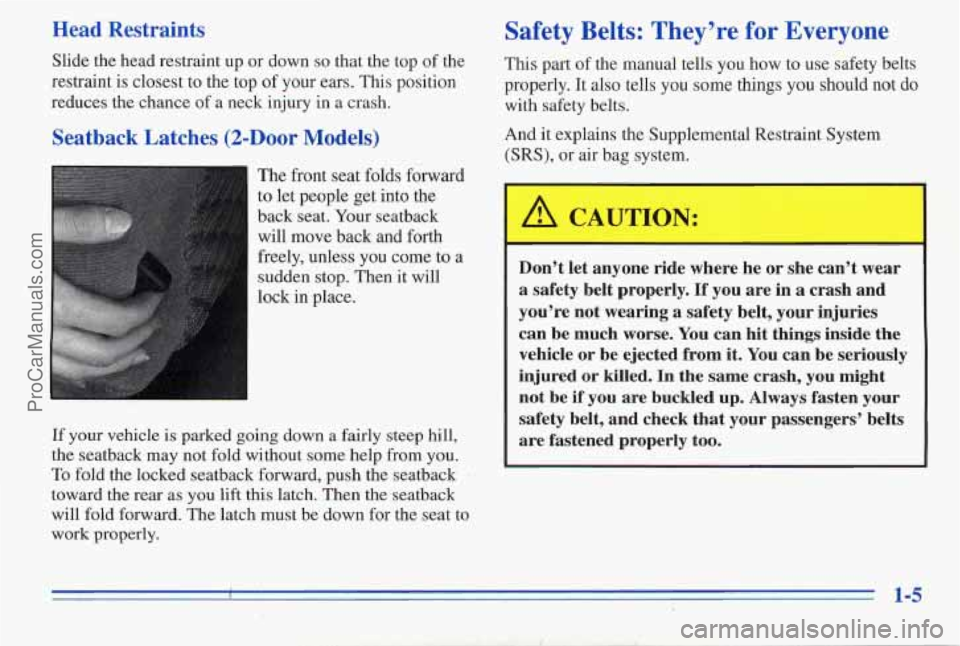
Head Restraints
Slide the head restraint up or down so that the top of the
restraint is closest to the top of your ears. This position
reduces the chance of a neck injury in a crash.
Seatback Latches (2-Door Models)
The front seat folds forward
to let people get into the
back seat. Your seatback
will move
back and forth
freely, unless you come to a
sudden stop. Then it will
lock in place.
If your vehicle is parked going down
a fairly steep hill,
the seatback may not fold without some help from you.
To fold the locked seatback forward, push the seatback
8
toward the rear as you lift this latch. Then the seatback
will fold forward. The latch must be down for the seat to
work properly.
Safety Belts: They’re for Everyone
This part of the manual tells you how to use safety belts
properly. It also tells
you some things you should not do
with safety belts.
And it explains the Supplemental Restraint System
(SRS), or air bag system.
A CAUTION:
Don’t let anyone ride where he or she can’t wear
a safety belt properly. If you are in a crash and
you’re not wearing a safety belt, your injuries
can be much worse. You can
hit things inside the
vehicle or be ejected from
it. You can be seriously
injured or killed. In the same crash, you might
not be
if you are buckled up. Always fasten your
safety belt, and check that your passengers’ belts
are fastened properly too.
ProCarManuals.com
Page 34 of 370
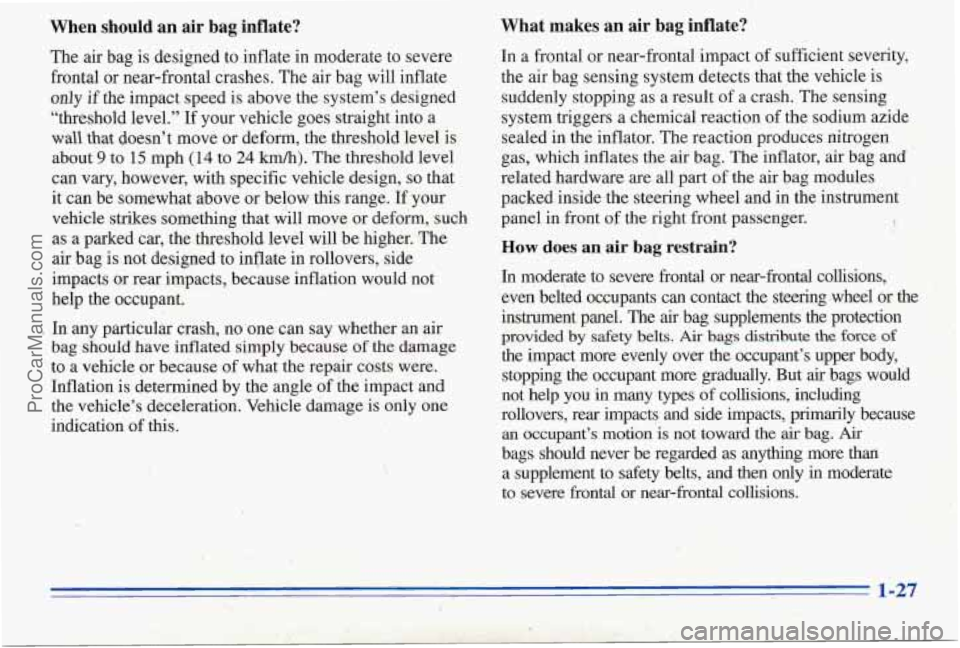
When should an air bag inflate?
The’ air bag is designed to inflate in moderate to severe
frontal or near-frontal crashes. The air bag will inflate
only if the impact speed
is above the system’s designed
“threshold level.” If your vehicle goes straight into a
wall that doesn’t move or deform, the threshold level is
about
9 to 15 mph (14 to 24 km/h). The threshold level
can
vary, however, with specific vehicle design, so that
it can be somewhat above or below this range. If your
vehicle strikes something that will move or deform, such
as a parked car, the threshold level will be higher. The
air bag is not designed to inflate in rollovers, side
impacts or rear impagts,
., - .because. iflation. would not
help the occupant.
. In any particular crash, no one can say whether an air
bag
should have inflated simply because of the damage
to a vehicle or because
of what the repair costs were.
Inflation is determined by the angle of the impact and
the vehicle’s deceleration. Vehicle damage is only one
indication of this.
., -: .. ,
., t: _,
.
What makes an air bag inflate?
In a frontal or near-frontal impact of sufficient severity,
the air bag sensing system detects that the vehcle
is
suddenly stopping as a result of a crash. The sensing
system triggers a chemical reaction of
the sodium azide
sealed in the inflator. The reaction produces nitrogen
gas, which inflates the air bag. The inflator, air bag and
related hardware are all part of the air bag modules
p,acked inside the steering wheel and in the instrument
panel
in front of the right front passenger.
How does an air bag restrain?
t
In moderate to severe frontal or near-frontal collisions,
even belted occupants can contact
the steering.whee1 or the
instrument panel. The
air bag supplements the protection
provided
by safety belts. Air bags distribute the force of
the impact more evenly over the occupant’s upper body,
stopping the occupant more gradually. But
air bags would
not help
you in many types of collisions, including
rollovers, rear impacts and side impacts, primarily because
an occupant’s motion’is not toward the air bag. Air
bags should never be regarded as anything more than
a supplement
to safety belts, and then only in moderate
to severe frontal or near-frontal collisions.
ProCarManuals.com
Page 67 of 370
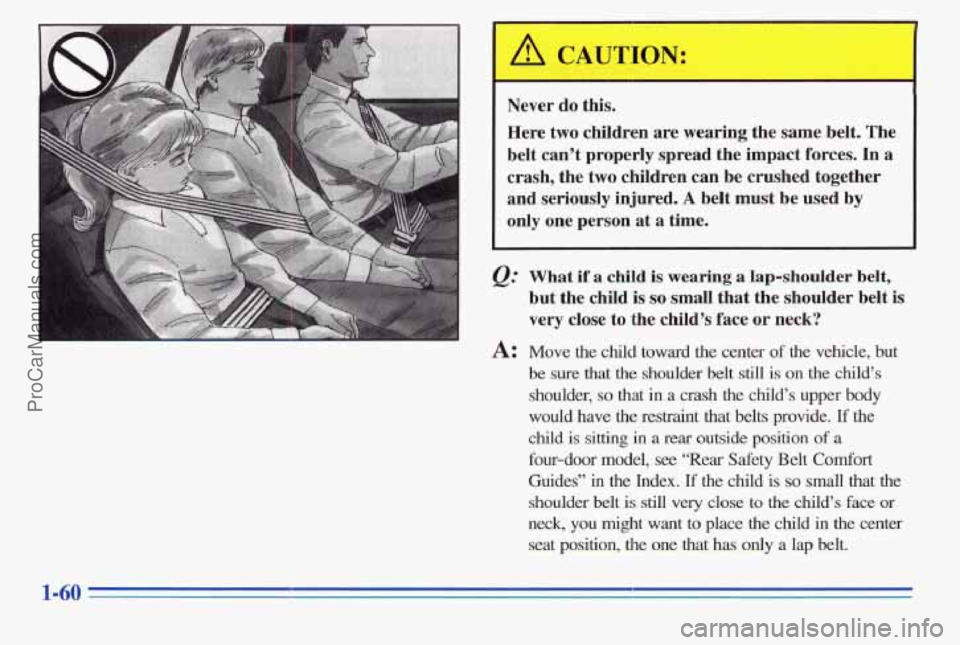
Never do this.
Here two children are wearing the same belt. The
belt can’t properly spread the impact forces.
In a
crash, the
two children can be crushed together
and seriously injured.
A belt must be used by
only one person at a time.
@ What if a child is wearing a lap-shoulder belt,
, but the child is so small that the shoulder belt is
A: Move the child toward the center of the vehicle, but
very close to the child’s face or neck?
be sure that the shoulder belt still is on the child’s
shoulder,
so that in, a crash ‘the child’s upper body
would.have the restraint that belts provide. If the
child is si.tting in a rear outside position of a
four-door model, see “Rear Safety Belt Comfort
Guides” in .the Index. If the child is so small that the
shoulder belt is still very close to the child’s face or
neck, YQU might want to place the child in the center
seat
positio~ the one that has only a lap belt.
1-60
ProCarManuals.com
Page 79 of 370

New Vehicle 66Break-InS’ Ignition Positions
Your modern Pontiac doesn’t need an elaborate
“break-in.” But
it will perform better in the long
run
if you follow these guidelines:
Don’t drive at any one speed
-- fast or
slow
-- for the first 500 miles (804 km).
Don’t make full-throttle starts.
Avoid making hard stops for the first
200 miles (322 km) or so. During this time
your new brake linings aren’t
yet broken
in. Hard stops with new linings can mean
premature wear and earlier replacement.
Follow this breaking-in guideline every
time
you get new brake linings.
Don’t tow a trailer during break-in, See
‘‘Towing a Trailer’’ in the Index for more
information.
C
A i E
With the ignition key in the ignition switch, you can twn
the switch to five positions.
ACC (A): This position lets you use things like the
radio and windshield wipers when the engine is
off. To
use ACC (Accessory), push in the key and turn it toward
you. Your steering wheel will stay locked.
LOCK (B): Before you put the key into the ignition
switch, the switch
is in the LOCK position. It’s also the
only position in which you can remove your key.
This
position locks your ignition, steering wheel and
transaxle. It’s a theft-deterrent feature.
ProCarManuals.com
Page 80 of 370
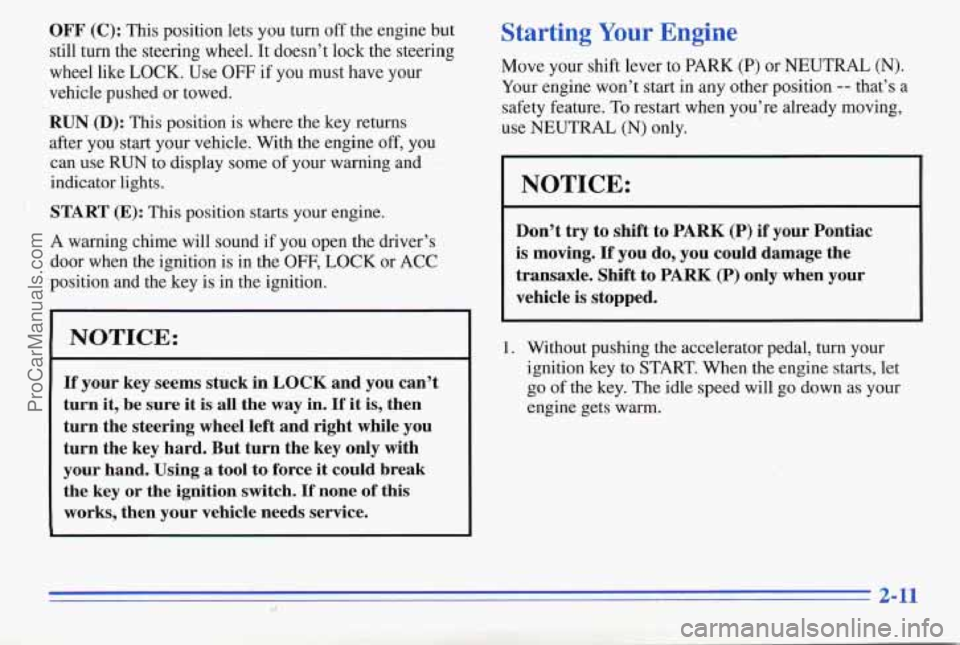
OFF (C): This position lets you turn off the engine but
still tuin the steering wheel. It doesn’t lock the steering
wheel like
LOCK. Use OFF if you must have your
vehcle pushed
or towed.
RUN (D): This position is where the key returns
after you start your vehicle. With the engine
off, you
can use
RUN to display some of your warning and
indicator lights.
: START (E): This position starts your engine.
A warning chime will sound
if you open the driver’s
door when the ignition is in the
OFF, LOCK or ACC
position and the key
is in the ignition.
NOTICE:
If your key seems stuck in LOCK and you can’t
turn it, be sure it
is all the way in. If it is, then
turn the steering wheel left and right while you
turn the key hard. But turn the key only with
your hand. Using
a tool to force it could break
the key or the ignition switch.
If none of this
works, then your vehicle needs service.
Starting Your Engine
Move your shift lever to PARK (P) or NEUTRAL (N).
Your engine won’t start in any other position -- that’s a
safety feature.
To restart when you’re already moving,
use
NEUTRAL (N) only.
NOTICE:
Don’t try to shift to PARK (P) if‘ your Pontiac
is moving.
If you do, you could damage the
transaxle. Shift to PARK
(P) only when your
vehicle is stopped.
1. Without pushing the accelerator pedal, turn your
ignition key
to START. When the engine starts, let
go of the key. The idle speed will go down as your
engine gets warm.
2-11
ProCarManuals.com
Page 81 of 370
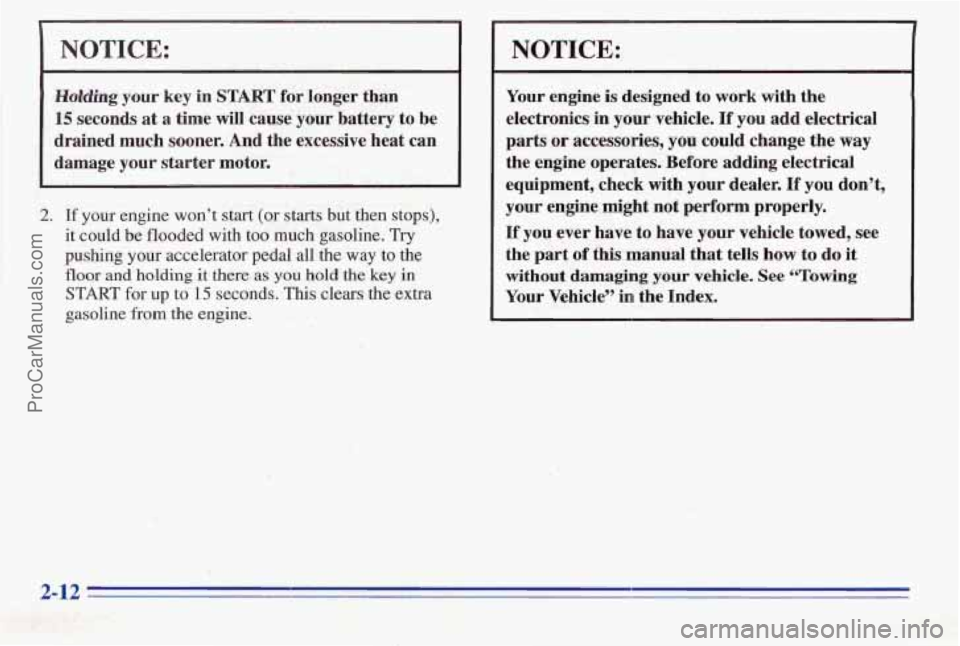
NOTICE:
Hdding your key in START for longer than
15 seconds at a time will cause your battery to be
drained much sooner. And the excessive heat can
damage your starter motor.
2. If your engine won’t start (or starts but then stops),
it could be flooded with too
much gasoline. Try
pushing your accelerator pedal all the way to the
floor and holding it there as you hold the key in
START for up to 15 seconds. This clears the extra
gasoline from the engine.
4
NOTICE:
Your engine is designed to work with the
electronics in your vehicle.
If you add electrical
parts
or accessories, you could change the way
the engine operates. Before adding electrical
equipment, check with
your dealer. If you don’t,
your engine might not perform properly.
If’ you ever have to have your vehicle towed, see
the part
of this manual that tells how to do it
without damaging your vehicle. See “Towing
Your Vehicle” in the Index.
2-12
ProCarManuals.com
Page 84 of 370
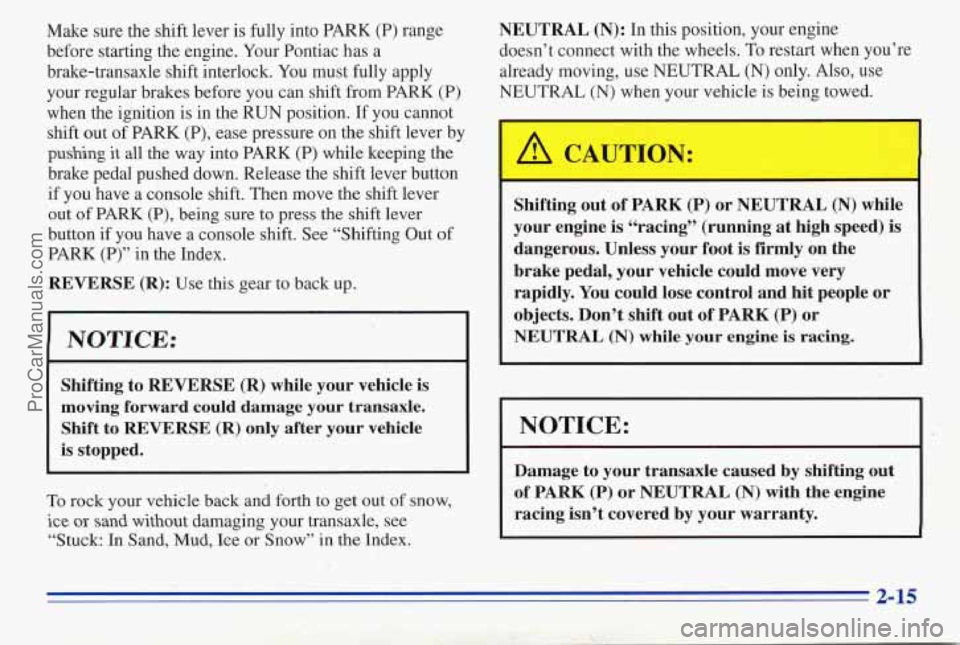
Make sure the shift lever is fully into PARK (P) range
before starting the engine. Your Pontiac has a
brake-transaxle shift interlock. You must fully apply
your regular brakes. before you can shift from PARK (P)
when the ignition is in the RUN position. If you cannot
shift out of PARK (P), ease pressure on the shift lever by
pushing it all the way into PARK (P) while keeping the
brake pedal pushed down. Release the shift lever button
if you have a console shift. Then move
the shift lever
out of PARK
(P), being sure to press the shift lever
button if you have a console shift. See “Shifting Out
of
PARK (P)” in the Index.
REVERSE (R): Use this gear to back up.
NOTICE:
.. .. ‘9: -. ~. - , . .. I. .,, :- . *.
Shifting to REVERSE (R) while your vehicle is
moving
forward could damage your transaxle.
Shift to REVERSE
(R) only after your vehicle
is stopped.
To rock your vehicle back and forth to get out of snow,
ice or sand without damaging your transaxle, see
“Stuck: In Sand,
Mud, Ice or Snow” in the Index.
NEUTRAL (N): In this position, your engine
doesn’t connect with the wheels. To restart when you’re
already moving, use NEUTRAL (N) only. Also, use
NEUTRAL (N) when your vehicle is being towed.
Shifting out of PARK (P) or NEUTRAL (N) while
your engine is “racing” (running
at high speed) is
dangerous. Unless your foot is firmly on the
brake pedal, your vehicle could move very
rapidly. You could lose control and hit people or
objects. Don’t shift out
of PARK (P) or
NEUTRAL (N) while your engine is racing.
NOTICE:
Damage,to your transaxle caused by shifting out
of PARK (P) or NEUTRAL (N) with the engine
racing isn’t covered by your warranty.
2-15
ProCarManuals.com
Page 85 of 370
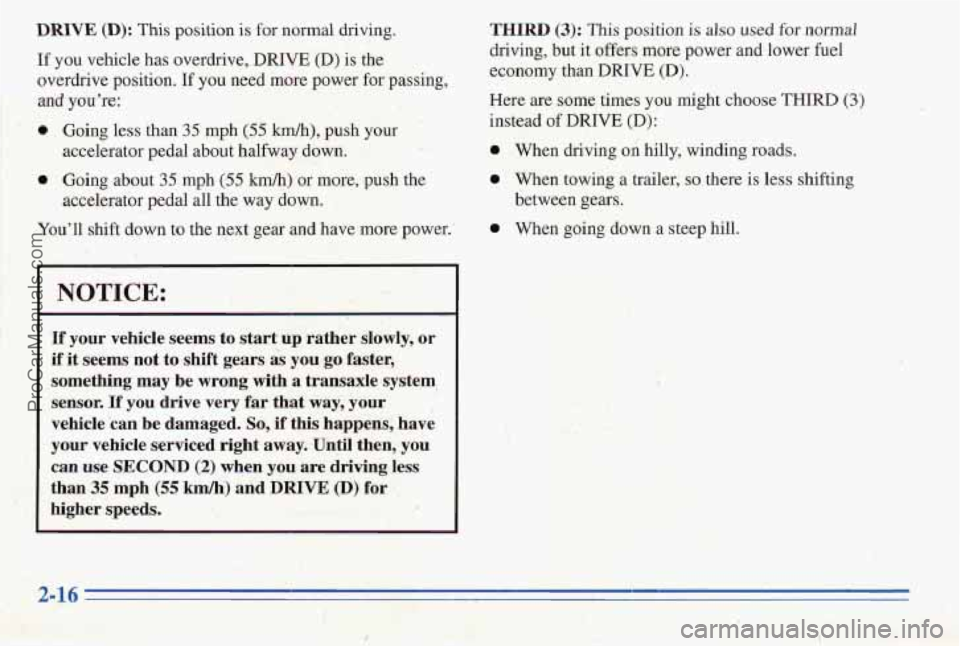
DRIVE (D): This position is for normal driving.
If you vehicle has overdrive, DRIVE (D) is the
overdrive position. If you need more power for passing,
0 Going less than 35 mph (55 km/h), push your
0 Going about 35 mph (55 kmk) or more, push the
You'll shift down to the next
gear and have more power.'
and you":
accelerator pedal about halfway down.
accelerator pedal all the way down.
THIRD (3): This position is also used for normal
driving, but
it offers more power and lower fuel
economy than
DRIVE (D).
Here are some times you might choose THIRD (3)
instead of DRIVE (D):
0 . When driving on hilly, winding roads.
0 When towing a trailer, so there is less shifting
0 When going down a steep hill.
between gears.
NOTICE:
'If your vehicle seems to startup rather slowly, or
if it seems
not to.sMft gears is you go faster,
something may be wrong with
a transaxle system
,sensor. If you drive very far that way, your
vehicle can
be damaged. So, if this happens; have
your vehicle serviced right away. Until'then,
you
can use SECOND (2) when you are driving less
than
35 mph (55 kmh) and DRn7E (D) for
higher speeds.
ProCarManuals.com
Page 88 of 370
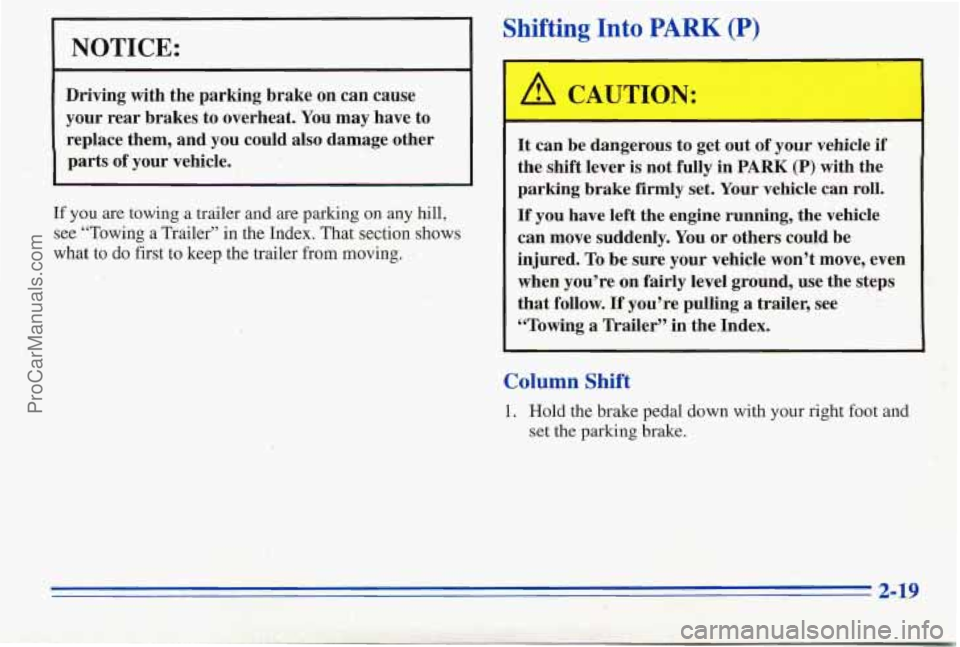
Shifting Into PARK (P)
NOTICE:
Driving with the parking brake on can cause
your rear brakes to overheat. You may have to
replace them, and you could also damage other
parts of your vehicle.
If
you are towing a trailer and are parking on any hill,
see "Towing a Trailer" in the Index. That section shows
what to do first
to keep the trailer from moving.
L
e dangerous to get out of your vehicle if
the shift. lever is not fully in
PARK (P) with the
parking brake firmly
set. Your vehicle can roll.
If you have left the engine running, the vehicle
can move suddenly.
You or others could be
injured.
TO be sure your vehicle won't move, even
when you're on
fairly level ground, use the steps
that follow.
If you're pulling a trailer, see
"Towing a Trailer'' in the Index.
Column Shift
1. Hold the brake pedal down with your right foot and
set the
parking brake.
ProCarManuals.com
Page 89 of 370
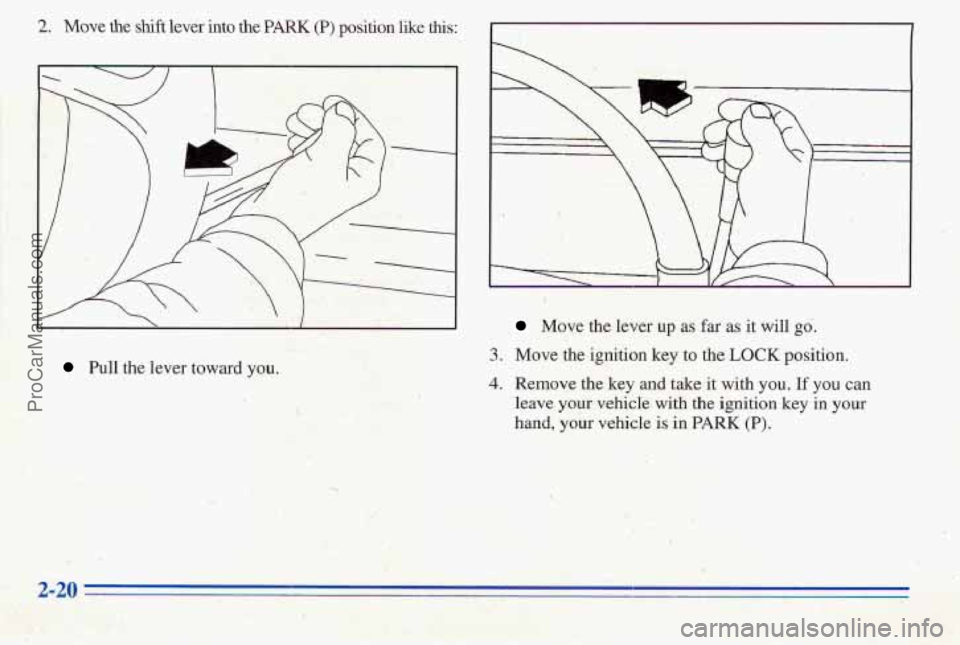
2. Move the shift lever into the PARK (P) position like this:
I' 1
!
Pull the lever toward you..
Move the.lever up as far as it will go.
3. Move the ignition key to the LOCK position.
4. Remove the key and take it with you. If you can
leave your vehicle. with the
ignition key in your
hand, your vehicle is in PARK (P).
ProCarManuals.com